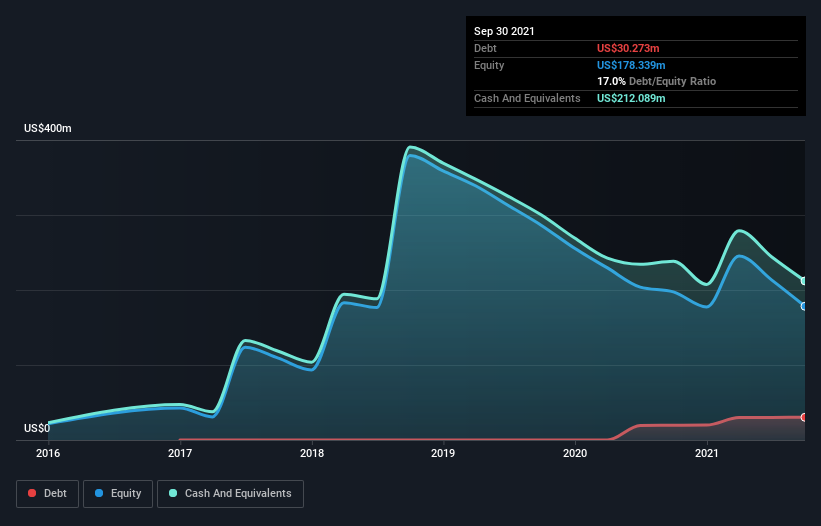Does G1 Therapeutics (NASDAQ:GTHX) Have A Healthy Balance Sheet?
David Iben put it well when he said, 'Volatility is not a risk we care about. What we care about is avoiding the permanent loss of capital.' So it seems the smart money knows that debt - which is usually involved in bankruptcies - is a very important factor, when you assess how risky a company is. We note that G1 Therapeutics, Inc. (NASDAQ:GTHX) does have debt on its balance sheet. But should shareholders be worried about its use of debt?
What Risk Does Debt Bring?
Debt assists a business until the business has trouble paying it off, either with new capital or with free cash flow. Ultimately, if the company can't fulfill its legal obligations to repay debt, shareholders could walk away with nothing. While that is not too common, we often do see indebted companies permanently diluting shareholders because lenders force them to raise capital at a distressed price. By replacing dilution, though, debt can be an extremely good tool for businesses that need capital to invest in growth at high rates of return. When we think about a company's use of debt, we first look at cash and debt together.
Check out our latest analysis for G1 Therapeutics
What Is G1 Therapeutics's Debt?
The image below, which you can click on for greater detail, shows that at September 2021 G1 Therapeutics had debt of US$30.3m, up from US$19.7m in one year. However, its balance sheet shows it holds US$212.1m in cash, so it actually has US$181.8m net cash.
How Strong Is G1 Therapeutics' Balance Sheet?
Zooming in on the latest balance sheet data, we can see that G1 Therapeutics had liabilities of US$26.8m due within 12 months and liabilities of US$38.3m due beyond that. Offsetting these obligations, it had cash of US$212.1m as well as receivables valued at US$5.24m due within 12 months. So it can boast US$152.2m more liquid assets than total liabilities.
This surplus strongly suggests that G1 Therapeutics has a rock-solid balance sheet (and the debt is of no concern whatsoever). With this in mind one could posit that its balance sheet means the company is able to handle some adversity. Simply put, the fact that G1 Therapeutics has more cash than debt is arguably a good indication that it can manage its debt safely. When analysing debt levels, the balance sheet is the obvious place to start. But it is future earnings, more than anything, that will determine G1 Therapeutics's ability to maintain a healthy balance sheet going forward. So if you want to see what the professionals think, you might find this free report on analyst profit forecasts to be interesting.
Over 12 months, G1 Therapeutics reported revenue of US$42m, which is a gain of 47%, although it did not report any earnings before interest and tax. With any luck the company will be able to grow its way to profitability.
So How Risky Is G1 Therapeutics?
We have no doubt that loss making companies are, in general, riskier than profitable ones. And we do note that G1 Therapeutics had an earnings before interest and tax (EBIT) loss, over the last year. And over the same period it saw negative free cash outflow of US$129m and booked a US$134m accounting loss. However, it has net cash of US$181.8m, so it has a bit of time before it will need more capital. G1 Therapeutics's revenue growth shone bright over the last year, so it may well be in a position to turn a profit in due course. By investing before those profits, shareholders take on more risk in the hope of bigger rewards. There's no doubt that we learn most about debt from the balance sheet. But ultimately, every company can contain risks that exist outside of the balance sheet. We've identified 3 warning signs with G1 Therapeutics , and understanding them should be part of your investment process.
If, after all that, you're more interested in a fast growing company with a rock-solid balance sheet, then check out our list of net cash growth stocks without delay.
Have feedback on this article? Concerned about the content? Get in touch with us directly. Alternatively, email editorial-team (at) simplywallst.com.
This article by Simply Wall St is general in nature. We provide commentary based on historical data and analyst forecasts only using an unbiased methodology and our articles are not intended to be financial advice. It does not constitute a recommendation to buy or sell any stock, and does not take account of your objectives, or your financial situation. We aim to bring you long-term focused analysis driven by fundamental data. Note that our analysis may not factor in the latest price-sensitive company announcements or qualitative material. Simply Wall St has no position in any stocks mentioned.

 Yahoo Finance
Yahoo Finance 
